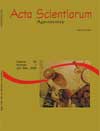<strong>Micromorphometric analysis of aggregates of Rhodic Hapludox under different management systems</strong>
Keywords:
no-tillage, digital images, aggregates
Abstract
The aim of this work is to characterize, using a micromorphometric analysis, the aggregates of a Hapludox submitted to different management systems. This work was carried out in a Rhodic Hapludox in Dourados-MS. The experimental design was in randomized blocks with four replications and treatments arranged in sub-subdivided plots. Treatments were established in two management systems (conventional and no-tillage), two doses of gypsum (zero and 2 t ha-1) and the use of two summer crops (soybean and corn). Aggregates were collected, in depths of 0 to 10 and 10 to 20 cm, using, in experimental proceedings, those held in diameter intervals of 9.52 and 4.76 mm, after sieving in a standard sieve set. For collecting aggregates, 40 x 40 cm trenches were opened and sieving was done in the field. Aggregate analyses were done by digital images obtained by scanner (300 dpi) of 60 aggregates arranged in a tray with untidy holes in order to preserve the principle of randomization. Images were later analyzed using the QUANTPORO program, and the analyzed characteristics of the aggregates were the area and its inter-relation with chemical attributes of the soil. The results demonstrated that no-tillage promoted the formation of larger aggregates; soybean as summer culture contributed to that structural effect in the soil; and the application of gypsum increased the aggregation in larger depths.Downloads
Download data is not yet available.
Published
2009-03-19
How to Cite
Cremon, C., Rosa Júnior, E. J., Serafim, M. E., & Ono, F. B. (2009). <strong>Micromorphometric analysis of aggregates of Rhodic Hapludox under different management systems</strong>. Acta Scientiarum. Agronomy, 31(1), 139-146. https://doi.org/10.4025/actasciagron.v31i1.6640
Issue
Section
Soils
DECLARATION OF ORIGINALITY AND COPYRIGHTS
I Declare that current article is original and has not been submitted for publication, in part or in whole, to any other national or international journal.
The copyrights belong exclusively to the authors. Published content is licensed under Creative Commons Attribution 4.0 (CC BY 4.0) guidelines, which allows sharing (copy and distribution of the material in any medium or format) and adaptation (remix, transform, and build upon the material) for any purpose, even commercially, under the terms of attribution.
2.0
2019CiteScore
60th percentile
Powered by 

2.0
2019CiteScore
60th percentile
Powered by 



















































